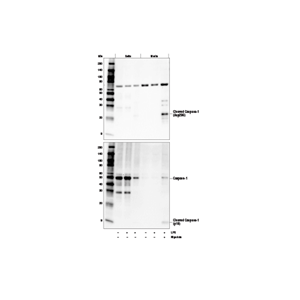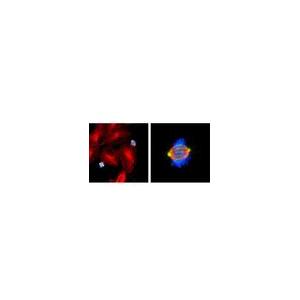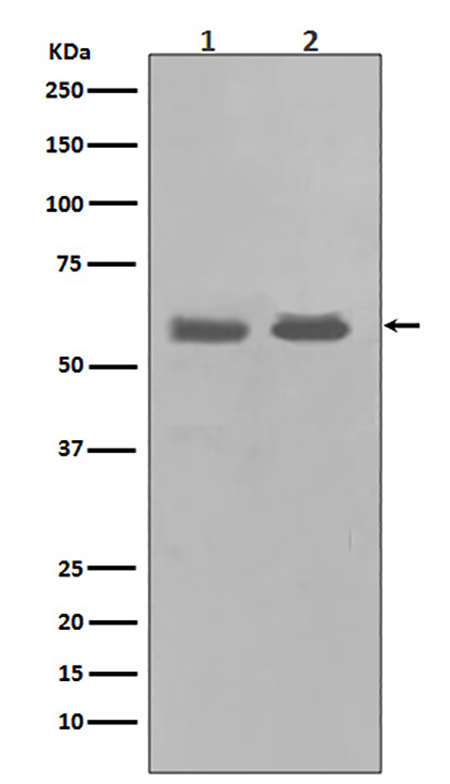产品概述
| 产品名称(Product Name) | Chk1 (10U9) Rabbit Monoclonal Antibody |
| 描述(Description) | Rabbit Monoclonal Antibody |
| 宿主(Host) | Rabbit |
| 应用(Application) | WB,IHC-P,ICC/IF,FC,IF-P |
| 种属反应性(Reactivity) | Human |
产品性能
| 偶联物(Conjugation) | Unconjugated |
| 修饰(Modification) | Unmodified |
| 同种型(Isotype) | IgG |
| 克隆(Clonality) | Monoclonal |
| 形式(Form) | Liquid |
| 存放说明(Storage) | Store at 4°C short term. Aliquot and store at -20°C long term. Avoid freeze/thaw cycles. |
| 储存溶液(Buffer) | Rabbit IgG in phosphate buffered saline , pH 7.4, 150mM NaCl, 0.02% New type preservative N and 50% glycerol. Store at +4°C short term. Store at -20°C long term. Avoid freeze / thaw cycle. |
| 纯化方式(Purification) | Affinity purification |
免疫原
| 基因名(Gene Name) | CHEK1 |
| 别名(Alternative Names) | Serine/threonine-protein kinase Chk1; CHEK1; CHK1 |
| 基因ID(Gene ID) | 1111 |
| 蛋白ID(SwissProt ID) | O14757 |
产品应用
| 稀释比(Dilution Ratio) | WB 1:2000, IHC-P/IF-P 1:100, ICC/IF 1:20-1:50, FCM 1:100 |
| 蛋白分子量(Molecular Weight) | 54kDa |
研究背景
DNA damage induced protein phosphorylation; regulation of mitotic centrosome separation; regulation of S phase; peptidyl-threonine phosphorylation; DNA repair; chromatin-mediated maintenance of transcription; negative regulation of mitosis; Serine/threonine-protein kinase which is required for checkpoint-mediated cell cycle arrest and activation of DNA repair in response to the presence of DNA damage or unreplicated DNA (PubMed:11535615, PubMed:12446774, PubMed:12399544, PubMed:14559997, PubMed:14988723, PubMed:15311285, PubMed:15665856, PubMed:15650047, PubMed:32357935). May also negatively regulate cell cycle progression during unperturbed cell cycles (PubMed:11535615, PubMed:12446774, PubMed:12399544, PubMed:14559997, PubMed:14988723, PubMed:15311285, PubMed:15665856, PubMed:15650047). This regulation is achieved by a number of mechanisms that together help to preserve the integrity of the genome (PubMed:11535615, PubMed:12446774, PubMed:12399544, PubMed:14559997, PubMed:14988723, PubMed:15311285, PubMed:15665856, PubMed:15650047). Recognizes the substrate consensus sequence [R-X-X- S/T] (PubMed:11535615, PubMed:12446774, PubMed:12399544, PubMed:14559997, PubMed:14988723, PubMed:15311285, PubMed:15665856, PubMed:15650047). Binds to and phosphorylates CDC25A, CDC25B and CDC25C (PubMed:9278511, PubMed:12676583, PubMed:14681206, PubMed:12676925, PubMed:12759351, PubMed:19734889, PubMed:14559997). Phosphorylation of CDC25A at 'Ser-178' and 'Thr-507' and phosphorylation of CDC25C at 'Ser-216' creates binding sites for 14-3-3 proteins which inhibit CDC25A and CDC25C (PubMed:9278511). Phosphorylation of CDC25A at 'Ser- 76', 'Ser-124', 'Ser-178', 'Ser-279' and 'Ser-293' promotes proteolysis of CDC25A (PubMed:9278511, PubMed:12676583, PubMed:14681206, PubMed:12676925, PubMed:12759351, PubMed:19734889). Phosphorylation of CDC25A at 'Ser-76' primes the protein for subsequent phosphorylation at 'Ser-79', 'Ser-82' and 'Ser-88' by NEK11, which is required for polyubiquitination and degradation of CDCD25A (PubMed:9278511, PubMed:19734889, PubMed:20090422). Inhibition of CDC25 leads to increased inhibitory tyrosine phosphorylation of CDK-cyclin complexes and blocks cell cycle progression (PubMed:9278511). Also phosphorylates NEK6 (PubMed:18728393). Binds to and phosphorylates RAD51 at 'Thr-309', which promotes the release of RAD51 from BRCA2 and enhances the association of RAD51 with chromatin, thereby promoting DNA repair by homologous recombination (PubMed:15665856). Phosphorylates multiple sites within the C-terminus of TP53, which promotes activation of TP53 by acetylation and promotes cell cycle arrest and suppression of cellular proliferation (PubMed:10673501, PubMed:15659650, PubMed:16511572). Also promotes repair of DNA cross-links through phosphorylation of FANCE (PubMed:17296736). Binds to and phosphorylates TLK1 at 'Ser-743', which prevents the TLK1-dependent phosphorylation of the chromatin assembly factor ASF1A (PubMed:12660173, PubMed:12955071). This may enhance chromatin assembly both in the presence or absence of DNA damage (PubMed:12660173, PubMed:12955071). May also play a role in replication fork maintenance through regulation of PCNA (PubMed:18451105). May regulate the transcription of genes that regulate cell-cycle progression through the phosphorylation of histones (By similarity). Phosphorylates histone H3.1 (to form H3T11ph), which leads to epigenetic inhibition of a subset of genes (By similarity). May also phosphorylate RB1 to promote its interaction with the E2F family of transcription factors and subsequent cell cycle arrest (PubMed:17380128). Phosphorylates SPRTN, promoting SPRTN recruitment to chromatin (PubMed:31316063). Reduces replication stress and activates the G2/M checkpoint, by phosphorylating and inactivating PABIR1/FAM122A and promoting the serine/threonine-protein phosphatase 2A-mediated dephosphorylation and stabilization of WEE1 levels and activity (PubMed:33108758).
研究领域





